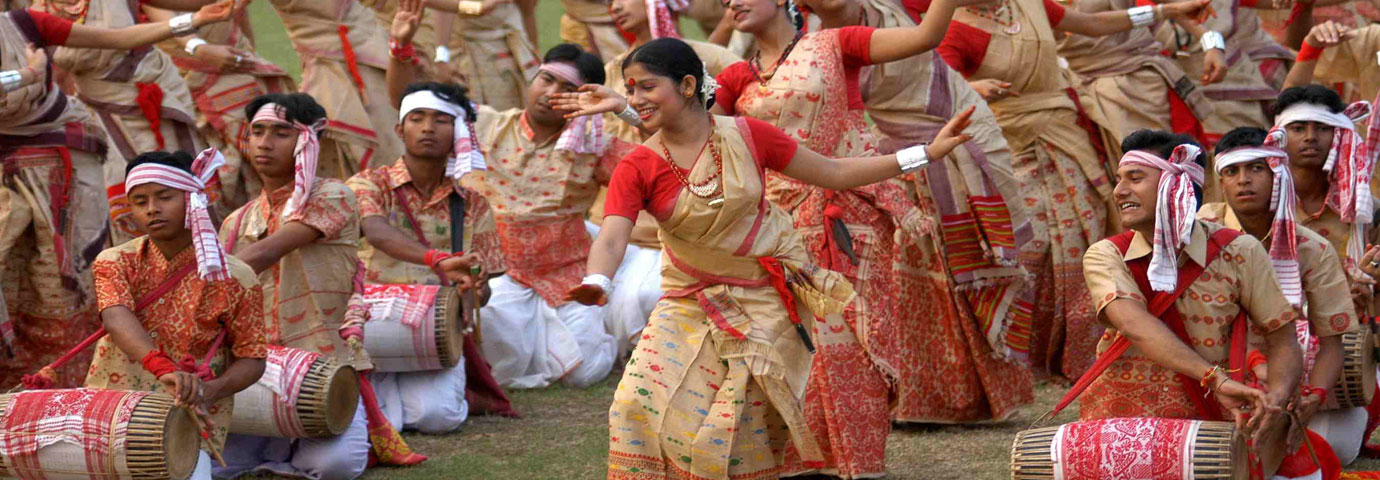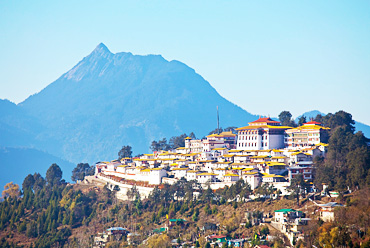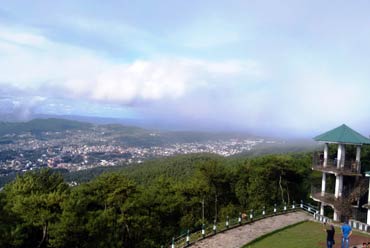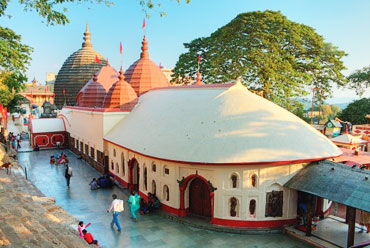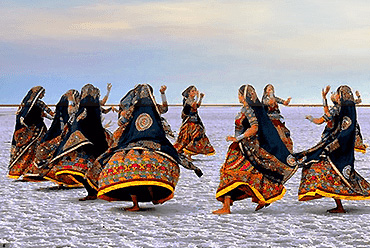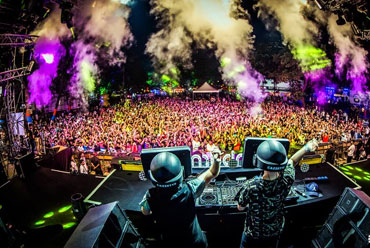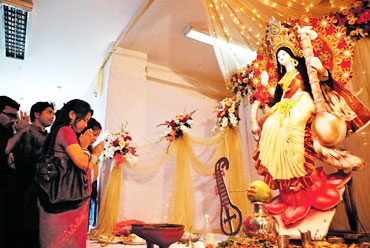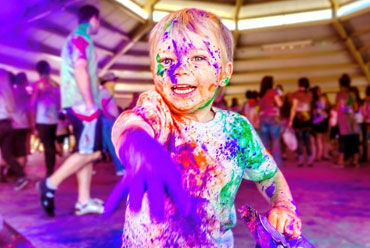Assam is a land of myths and mystery for those who are not familiar with it. The Land of Red River and Blue Hills, as it is described, has an enchanting beauty. It has a unique landscape with sprawling tea gardens and unending stretches of paddy fields interspersed with groves of coconut, betel nut, and banana trees. Its population is a confluence of streams of different races and tribes like the Austric, the Aryans, Negroid, Indo-Burmese, Indo-Tibetans, and Mongoloid. They have enriched each other and have evolved to give a distinctive identity to the Assamese people. Vast majorities of the people in the state, as in most other states in the country, are closely associated with agriculture. It is, therefore, natural that almost all the important festivals and dances are rooted in agricultural activities and the changing moods of nature. The festivals of Assam are a synthesis of diverse cultures, which have blended to become a common heritage of the people of the state.
Assamese people, irrespective of caste, creed, religion, faith, and belief celebrate the Bihu. There are three Bihu festivals in a year, namely, Rongali, Bhugali, and Kangali. Each Bihu coincides with a distinctive phase in the farming calendar. The Bohag Bihu marks the New Year at the advent of seeding time, the Kati Bihu marks the completion of sowing and transplanting of paddies, and the Magh Bihu marks the end of the harvesting period. Bohag Bihu is also called the Rongali Bihu or the Festival of Merriment, Magh Bihu is also called Bhugali Bihu or the Festival of Food, and Kati Bihu is called Kangali Bihu or the Festival of the Poor.
Of the three Bihu festivals, which are secular and non-religious, the Bohag Bihu ushers in the period of greatest enjoyment and marks the arrival of spring, the agricultural season. The folk songs associated with the Bohag Bihu are called Bihugeets or Bihu songs. The Bohag Bihu lasts for several days during which "the young people in the village may be seen moving about in groups gaily dressed or forming circles in the midst of which the prettiest girls dance" singing songs of love and romance. The merriments include dances accompanied by the wild and lusty beats of dhol and pépa (buffalo hornpipe) and gagana. Songs sung in this Bihu are woven around themes of love and often carry erotic overtones. People adorn traditional attires like dhoti, gamosa, and saadar mekhela.
Time of The Year
Rongali or Bohag Bihu derives its name from Sanskrit Vishuvam when day and night are rendered equal through the vernal equinox. People welcome the spring season and pray for a bountiful and rich harvest.This festival is celebrated in the month of Bohag (Mid-April), the first month of the Assamese calendar. The exact date in the English calendar varies, but the festival normally starts from the 13th day of the month of April.
Celebrations
The weeklong festival of Bohag Bihu starts from the Vishuva Sankranti day. It comes when the first shower of the year, the blossoming of varieties of colorful flowers, the sweet voice of the cuckoo and the fragrant breeze transform the environment into an earthly paradise. Rongali Bihu inspires unbounded joy and enthusiasm expressed through dances, songs, and other festivities.
The first day of the festival week is called Garu Bihu and is dedicated to the cattle and livestock. In the morning, the cattle are taken to nearby ponds or riverbanks for a ceremonial bath. The horns and heads of the animal are rubbed with the paste of newly harvested turmeric and black gram. Pieces of aubergine, turmeric, and bottle gourd (Lagenaria siceraria) are thrown on the cattle amidst shouts of "Lau kha, bengena kha, bachare bachare barhi ja". The animals are tethered with new ropes and garlanded with a collection of different kinds of leaves.
The rest of the weeklong celebrations are known as Manuh Bihu. A mood of festivity and gaiety is seen throughout Assam during the seven days of Rongali Bihu. Some people celebrate it for almost a month. Hundreds of young men and women perform Bihu dances in the bihutolis and sing to the accompaniment of dhol and pépa, a flute made of buffalo horns. The sensuous and brisk Bihu dance is performed in the fields, at roadsides and over specially erected stages. They also sing couplets expressing love for the sweethearts. The Bihugeets, as they are called, are tuned to rhythmic beats of the dhol, to which the people dance.
Nowadays, Mukoli Bihus are not common any more. In towns and cities, there are well-organized Bihu fairs where professional or amateur troupes perform Bihu songs on stage to the accompaniment of dance. Various contests are also organized where young men and women compete in dancing to the tune of Bihu songs, and the best dancer of each category is awarded the title of Bihu Kunwar and Bihu Kunwaree, respectively.
Rituals
During the Bihu days, everyone wears new clothes. Special cakes, known as pithas, are baked in every household. People invite each other for feasts. Fairs are organized at several places and the mood of festivity is palpable everywhere. Women present gamosas or self-woven napkins to the men, and sweets are distributed to neighbors, relatives, and friends. Each day different programs are organized and people participate in large numbers.
Rongali Bihu is associated with two types of folk dances. The first, called Husari, is carol singing and dancing in a group consisting of only men, led by the elderly ones. The group starts visiting the houses in the village before noon, to dance and sing benedictory songs. Husari songs are more religious than festive. The residents honor the group by offering paan (betel leaf), tamul (areca-nut), sweets, and money in a sarai (brass dish with stand) as daksina (offering). The funds collected are spent for repairing the village Namghar (community prayer hall) and for community feasting.
The other dance is performed in open fields or groves by young unmarried men and women, dancing and singing sometimes through the night. The girls dress in their best traditional clothes-a red floral mekhela with a red border, a shawl woven out of the golden silk fibers, and a red blouse. Their feet and palms are painted with the red pigments made of myrtle leaves. Kapou phul, a beautiful purple colored orchid, is very popular with the girls. The young men wear dhoti and kurta and tie the gamosa around their heads and waists.
The brisk and sensuous Bihu dance with the various movements of hips, arms, and the upper parts of the body reflects man's primeval urge for fertility, survival, and growth. Although in course of time, the influence of different cultures has introduced changes in the celebrations, its originality and emotions are very much alive. The annual Bihu festival of the Brahmaputra valley not only remind the people of the glorious traditions of Assam, but also tell the story of man, built on the edifice of agricultural and pastoral life.

